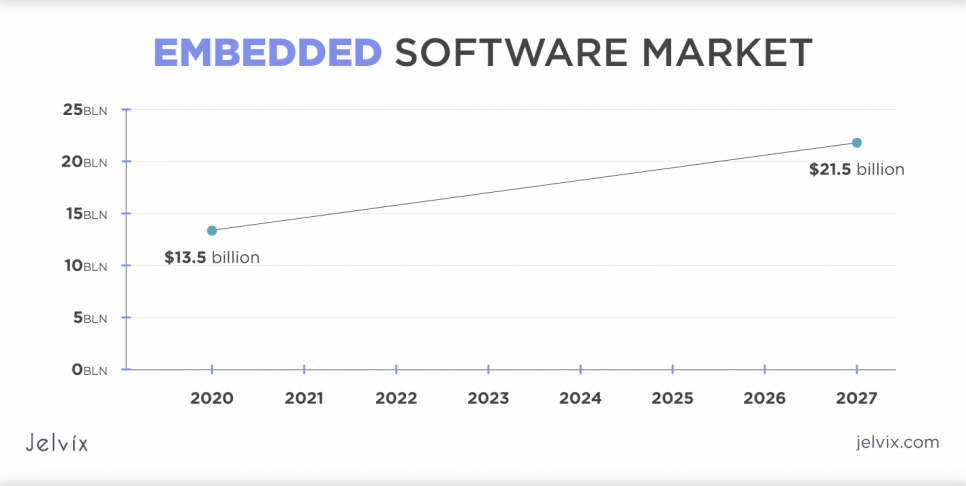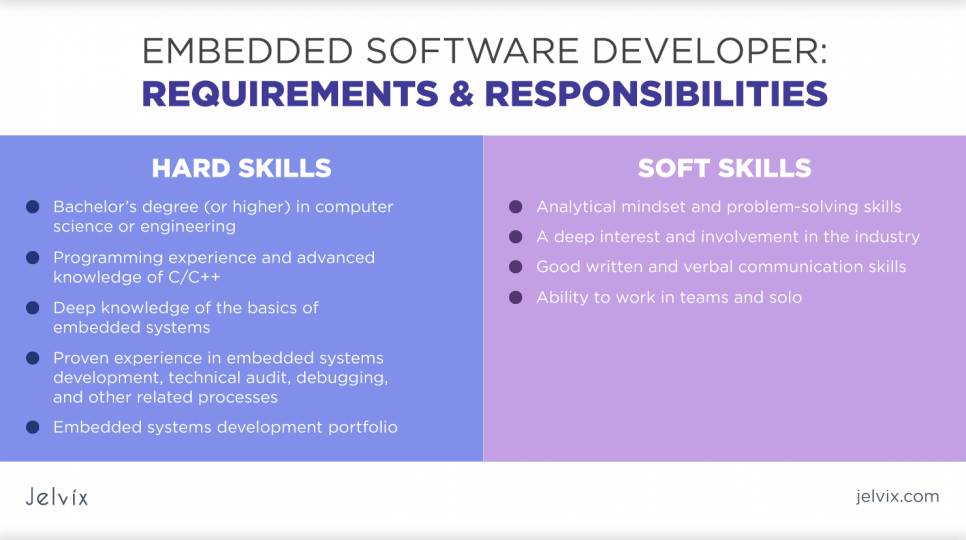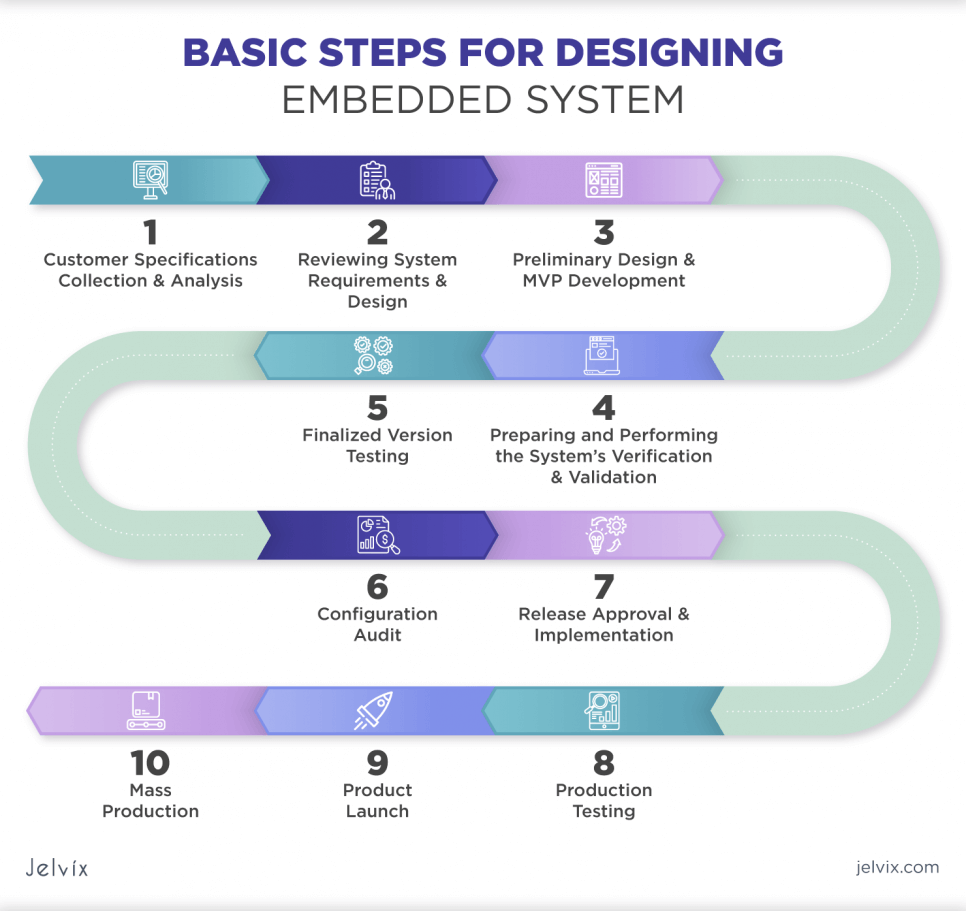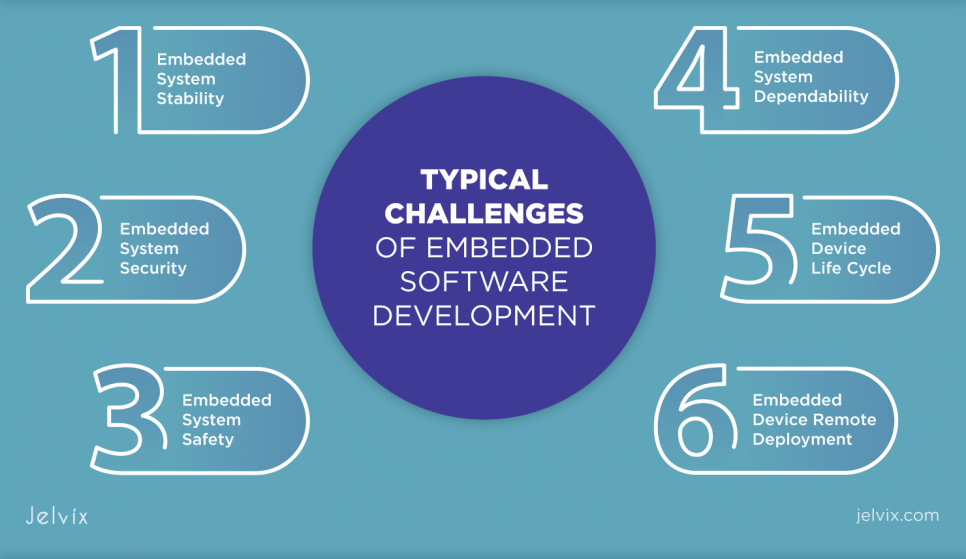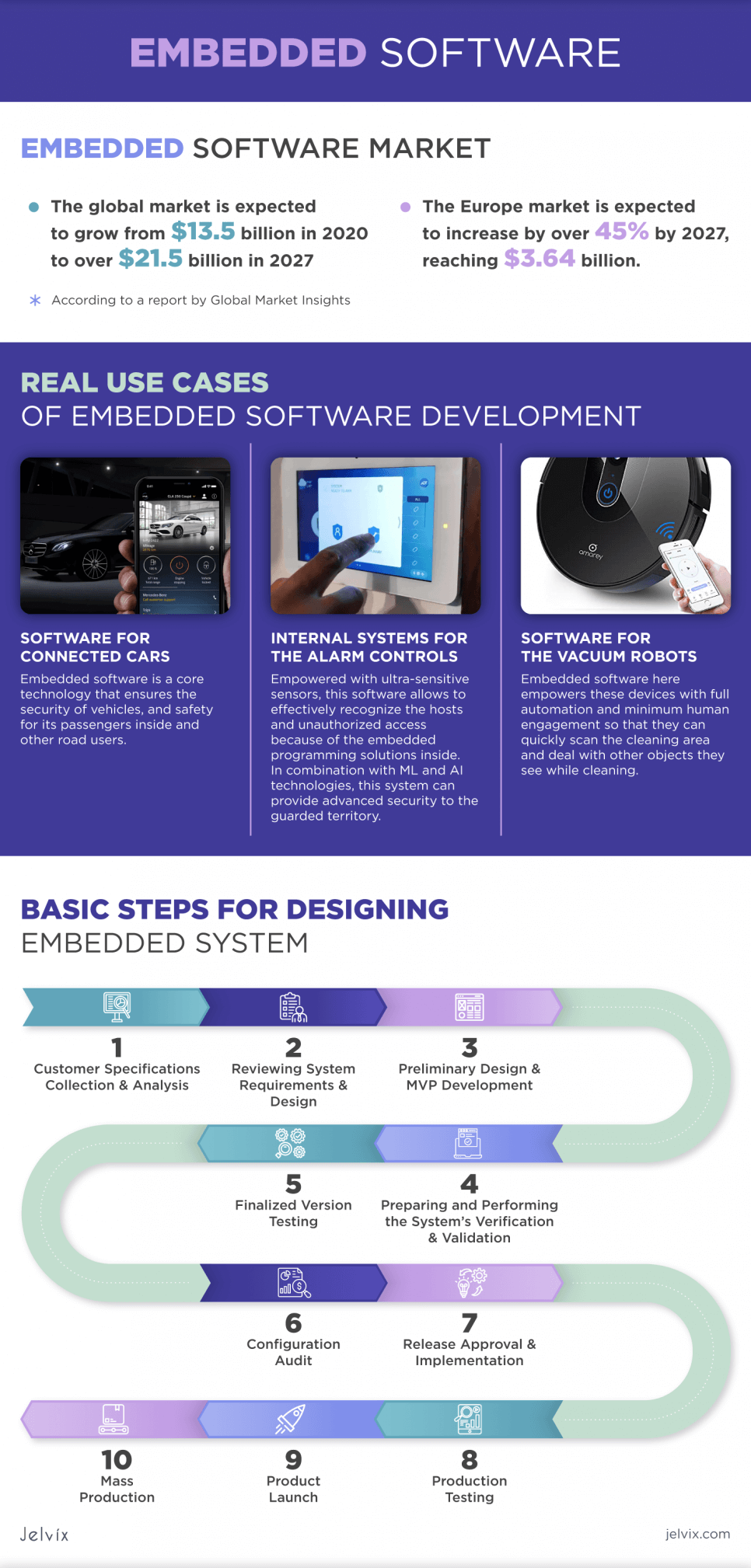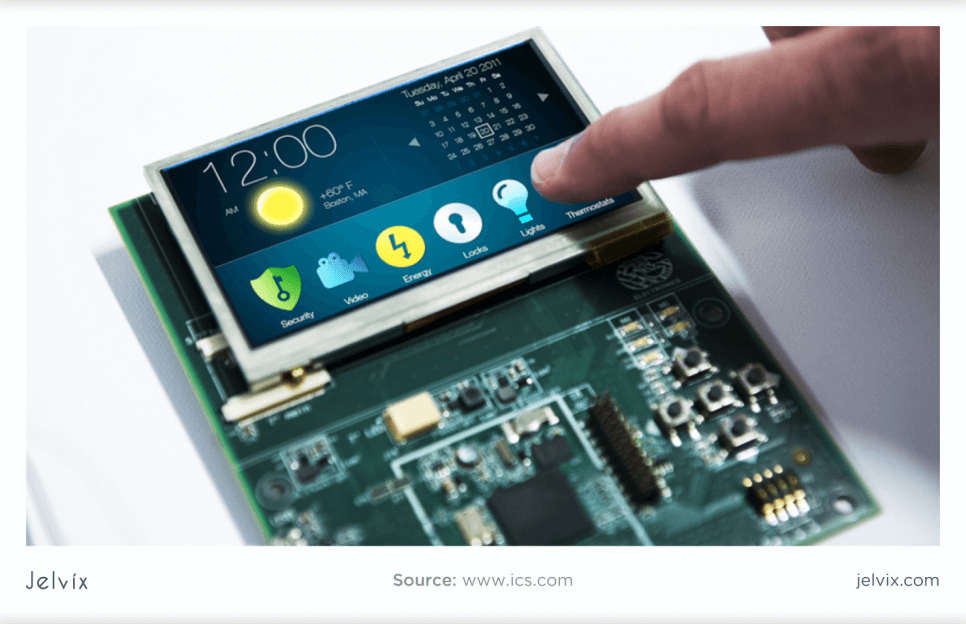Being developed more than 50 years ago, embedded software solutions have been gradually integrated into the life of nearly every household. Today, these systems surround us at every turn yet have a huge impact on the Internet of Things evolution.
According to a report by Global Market Insights, the embedded software market is expected to grow from $13.5 billion in 2020 to over $21.5 billion in 2027. Similarly, the embedded software market in Europe is expected to increase by over 45% by 2027, reaching $3.64 billion.
These statistics are only a few signs of the rising demand for embedded software specialists. In this article, we’ll make a comprehensive overview of embedded software engineering, covering its definition, use cases, life cycle, and challenges this field that business owners can potentially uncover once it’s been implemented.
What Is Embedded Software Engineering & Where Is It Used?
Embedded software is a system designed and implemented into various hardware and is not solely limited to traditional computer systems. Basically, that’s the “brain” of any smart device, which actually makes its value.
Examples of embedded software solutions can be found nearly anywhere, from vacuum robots and TV remote controls to digital cameras and even traditional calculators. All these devices are powered by embedded systems, though it might not seem that obvious at first.
However, it’s also worth mentioning that embedded software is more specific than the general term “software” and is different from “firmware” (which is something in between the hardware and software, which is created from the source code but is closely tied to the hardware it runs on). Here are some real use cases of embedded software development:
- Software for connected cars. Embedded software is a core technology that ensures the security of vehicles and the safety of their passengers inside and other road users.
- Internal systems for the alarm controls. Empowered with ultra-sensitive sensors, this software allows us to effectively recognize the hosts and unauthorized access because of the embedded programming solutions inside. In combination with ML and AI technologies, this system can provide advanced security to the guarded territory.
- Software for the vacuum robots. Embedded software here empowers these devices with full automation and minimum human engagement so that they can quickly scan the cleaning area and deal with other objects they see while cleaning.
As you can see, embedded software engineering is no longer a trend but an essential tech solution widely implemented nowadays. Now it’s time to better understand the specifics of embedded software development.
Embedded Product Development: Getting the Best Specialists
An embedded engineer will work on designing the embedded systems for performing certain tasks and functions. These specialists can work on a specific part of a system or help deliver the entire system to ensure it works properly.
Principal Categories of Embedded Engineers
Depending on the type of project and scope of work, you may require to search for a specialist with a certain skill set to quickly and effectively accomplish the desired outcomes. At the same time, knowing different categories of embedded engineer specialists will help you to make the most resource-effective and informative decision on which specialist you should choose.
- Junior Embedded Systems Engineer. This expert typically performs the basic software development tasks, often with supervision. In some cases, they can participate in technical analysis, diagnosing the root causes and their solutions.
- The median salary of these experts is $67,200 annually.
- Senior Embedded Systems Engineer. Compared to Juniors, Senior developers get more autonomy in creating and improving the embedded software and systems. Usually, they can also supervise junior developers and guide the embedded engineering process.
- In this category of experts, the median salary is higher, standing at $105,570 per year.
- Principal Embedded Firmware Engineer. The developers with advanced knowledge in firmware engineering can be in charge of the entire system development. They have extreme autonomy, are often involved in various stages of embedded engineering, and usually communicate with the top leadership.
- The median salary in the highest range of embedded engineers currently stands at $202,000.
Apart from that, there is also a similar position of the embedded architect, according to which the specialist can participate in vital decisions concerning the system’s structure, functionality, and development.
This role is pretty similar to “project management” in terms of embedded software engineering, as it also covers choosing the programming language and relevant tools, as well as deciding how the components will interact.
Read more about the most common software development strategies and take a look at their benefits and drawbacks.
Embedded Software Developer: Requirements & Responsibilities
Embedded engineers are required to have a wide range of different hard and soft skills to perform their tasks properly. Here is the list of the basic requirements that can help business owners to choose the best expert within this field.
The Basic Hard Skills for Embedded Engineer Include:
- Bachelor’s degree (or higher) in computer science or engineering;
- Programming experience and advanced knowledge of C/C++;
- Deep knowledge of the basics of embedded systems, including the components, system development, life cycle, tools, and industry trends that may come in handy for upcoming projects;
- Proven experience (or project involvement) in embedded systems development, technical audit, debugging, and other related processes;
- Embedded systems development portfolio showcases the work in a range of systems, firmware development, and real-time operating systems, with seven to eight years of experience (for Seniors) and at least ten years of experience (for Principals).
Some of the Soft Skills for Embedded Developers are:
- Analytical mindset and problem-solving skills;
- A deep interest and involvement in the industry;
- Good written and verbal communication skills;
- Ability to work in teams and solo.
All these skills are a must for hiring a dedicated developer in embedded engineering.
To be able to better understand how the process of embedded system development actually goes, let’s briefly review the basics of the embedded systems engineering field. This includes the process specifics and challenges, what makes embedded systems so important nowadays, and why those will remain relevant in the future.
Basic Components of Embedded Systems
Previously, we have already discussed the detailed history and construction of the embedded system, so below, you’ll find a brief overview of its three basic layers: hardware, software, and operating system.
Hardware
This component is a physical object that starts the user interaction. Typically, it includes a set of different equipment, which is fundamental for the software implementation, such as:
- User interface: features, buttons, and display;
- Power supply, with the help of which the system charges;
- RAM or ROM memory;
- Other specific hardware: timer, sensors, ports, microphones, LIDAR, etc.
All these options ensure the device’s usability in practice yet provide the “need” for building the relevant software solution for each of the functions listed.
Software
This component implies creating the machine code with the help of different programming languages and frameworks. In other words, that’s the “brain” that manages the hardware.
Embedded Operating System
A specialized operating system designed to perform certain tasks for a device (other than computers), that’s an environment in which the code is executed that allows the device to do its job.
Basic Steps for Designing Embedded System
Having reviewed the main components of embedded software solutions, it’s essential to look closer at the process of software development for embedded systems. In fact, it implies a variety of different stages, from planning and design to testing and release. Here is a quick overview of the development stages for embedded software:
- Customer Specifications Collection & Analysis. The initial stage requires deep research into the market trends. It’s essential for the embedded system to “hook” its audience with features that are relevant to the customers. Additionally, this information can set the pace for the next stages of project development.
- Reviewing System Requirements & Design. Next, it’s important to evaluate the technical potential of your project by planning the most effective and user-friendly design. The Embedded system should fit certain hardware and operations systems to be able to perform its basic functions.
- Preliminary Design & MVP Development. Here, developers start creating the early versions of the embedded system according to the specifications and requirements outlined previously. It helps to see the vulnerabilities and find more opportunities for product improvement. Additionally, that’s a great way to test the beta version of a system with minimal input, which can potentially save you time and resources.
- Preparing and Performing the System’s Verification & Validation. This stage basically “approves” the functions of the embedded system and ensures it meets all the requirements and technical specifications according to the existing regulations (if there are any).
- Finalized Version Testing. This stage is excellent for reviewing the final version of your embedded system for the bugs, technical errors, and other issues that can decrease the system’s efficiency and result in a poor user experience.
- Configuration Audit. At this stage, the embedded system functions and physical configurations are reviewed, with the ability to add, remove, or modify certain product functions.
- Release Approval & Implementation. It’s one of the key stages in which the embedded system is finally configured and implemented into the hardware it’s been designed for.
- Production Testing. Here, the system is examined in terms of its performance along with the hardware it’s been designed for. Another great advantage of this stage is the ability to ensure the product is ready to meet the audience and will fully meet the expectations of its target audience.
- Product Launch. When the product is ready to meet the customer, usually, a limited line is produced. Developers can also release the updates and debugged versions to improve the usability and experience of the product that runs under the embedded system (though this option might not be available for some devices, such as a coffee machine, for example).
- Mass Production. The last stage is the green light to full production of the product, after which the project is marked as completed.
According to the stages outlined above, it becomes more than clear that embedded systems software engineering is an extremely complex and multi-aspect process that requires comprehensive preparation and deep knowledge of software development and hardware specifications.
Typical Challenges of Embedded Software Development
Finally, it’s also important to mention essential pitfalls a business might uncover once it implements the embedded software development service. Typically, the core challenges within the field are strongly related to the specifics of embedded software in terms of its implementation into various devices, particularly in the scope of IoT solutions.
Nevertheless, all the challenges stated below require to be addressed during the embedded software engineering process, covering both hardware and firmware aspects.
Embedded System Stability
When designing the embedded system, engineers must follow a standardized approach to ensure its stability and eliminate unpredictable behavior. This helps to make sure the devices are completely safe for the user’s and other people’s lives, yet provide the exact functions they have been created for.
Embedded System Security
Security compliance is another aspect that cannot be overlooked in embedded systems. Since the embedded systems are mainly connected to a particular device and can be controlled through the mobile app, it’s essential to ensure that there are no risks of data leaks or system breaches.
For most IoT devices, the regulatory standards today are mainly addressing the application, management, network, perception/physical layers, as well as personal data privacy. Some of the widely used examples of data protection regulation include General Data Protection Regulation – GDPR (EU), Personal Data Protection Act – PDPA (Singapore), California Consumer Privacy Act – CCPA (US), and Data Protection Act – DPA (UK).
Embedded System Safety
Finally, the devices with embedded systems should provide maximum safety and feature no hazards in the system for safety or life, as well as in critical environments. Currently, most embedded systems are not upgraded regularly to prevent hacks, which consequently may hit the safety of the device owners.
Typically, this aspect relates to health and wellness gadgets, which require extreme attention at both the design and maintenance stages.
Embedded System Dependability
There are many industries, the facilities of which are highly dependent on embedded system control. Ransomware cyberattacks can hit the performance of such systems, which can result in catastrophic consequences. For this reason, it’s essential to continually consider the ways in which it can be relieved, as well as consider the precautions for improving the security of embedded systems.
Embedded Device Life Cycle
Compared to PCs, smartphones, and tablets, embedded devices feature a much longer lifespan and slowly lose their relevance with time. Therefore, when manufacturers plan to launch an embedded system, they need to consider the potential threats and probable development paths for their products for decades.
The ideal embedded system software should be secure from a wide range of threats, including both current and those which can arise in the nearest future. Though this process seems really challenging, it is still worth considering in terms of a device’s life cycle.
Embedded Device Remote Deployment
Not all devices with embedded systems require direct interaction with their users. The IoT solutions already have numerous examples of gadgets that are managed through mobile (using Wi-fi), cellular, or Bluetooth technologies.
That is why manufacturers should also consider the add-on security layers that prevent any intrusion into the corporate environment.
The Future of the Embedded Systems Software Trend
The emerging trend for embedded systems developers will keep evolving because of many factors. The first and most important factor is their advantages for the software development industry, including their long life cycle, powerful performance, and resource efficiency in development and maintenance.
Along with that, the embedded systems have already been implemented in a wide range of products and tech solutions, including the Internet of Things, Big Data, Smart Vehicles, and Smart Home environments, which are already in use by millions of people across the world.
Increasing demand for embedded systems will remain relevant in the future because of its high involvement in the wearable electronics market, which is expected to reach $41.24 billion by 2025. It becomes even more essential for the healthcare industry, the medical device market, which can be valued at over $1.1 trillion in the nearest 3 years. Embedded OS will remain highly valuable for automotive, which is to be valued at $10 billion by 2027.
These are only a few examples that showcase the value of embedded engineering in the upcoming decades. Nevertheless, all those uncover a large potential for business owners to develop innovative solutions and become trendsetters within their target industries!
Conclusion
Embedded system software development has already become an essential tech solution for many manufacturers across various industries. However, this process is more specific rather than creating standard software with basic functions.
To create an effective embedded system, developers also need to take into account the hardware specifics, project requirements, and other essential aspects that make the system stable, functional, and actually valuable for consumers. That is why business owners should consider hiring a dedicated team of developers to provide advanced support to their project across all the stages of its development.
With years of presence on the market, Jelvix empowers many companies with innovative solutions and advanced technologies in software engineering. Our team features first-class development experts ready to get started right away to achieve the best results within the shortest time frames.
Contact Jelvix for a personal consultation on embedded systems software engineering to empower your project development process today!
People Also Ask
What is embedded development?
Embedded development is the construction process in which manufacturers implement the software into everyday products that consumers use in their daily routines. This scope covers a wide range of different items across multiple industries, which consequently has opened up plenty of career paths for IT professionals.
Typically, embedded development can now be found in home products, tech gadgets, vehicles, appliances, and other items that are used on a daily basis.
What do embedded software engineers do?
Embedded software engineers are responsible for designing, developing, and maintenance of the embedded systems in products. Usually, this includes software development and requires a deep understanding of the embedded systems’ functionality and target industry trends.
Nevertheless, this job doesn’t imply a predefined set of responsibilities and typically varies by organization, its goals, and product specifics in particular.
What is embedded software vs software?
Embedded software is a type of software that is embedded in hardware or non-PC devices. As a rule, it’s written for the particular hardware to meet its tech requirements and is designed based on the computing capabilities of a certain device.
On the contrary, “software” is a more general term that covers programs and other operating information used by a computer, regardless of the technical capabilities of the hardware or devices it runs on.
Is an embedded software engineer a software engineer?
Similar to software engineers, embedded software developers specialize in being able to expertly code, test, write and maintain the software. However, the key difference between these two roles is the ability of the last one to adjust the software to the tech requirements of certain hardware, in addition to the required programming skills.
Need a qualified team of developers?
Start your embedded development project with our expert engineers.


